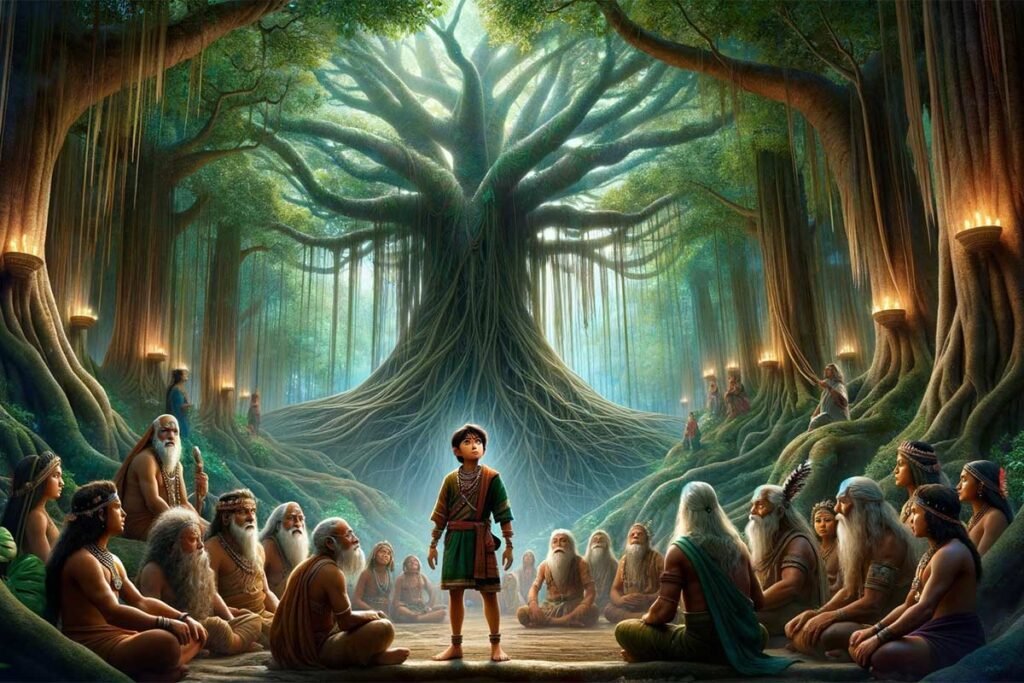In the western part of Odisha, where the dense forests of Ushakothi spread their ancient arms, there existed a world where nature spoke and spirits whispered. The tribes living near these woods believed in the sacred spirits that protected their lands and guided their lives.
The tale begins with a young tribal boy named Kedar, known for his extraordinary ability to understand the language of the forest. He could comprehend the murmurs of leaves, the whispers of the wind, and even the silent conversations of the animals. This gift was bestowed upon him by the Spirit of Ushakothi, the guardian of the woods.
One fateful night, a terrifying roar echoed through Ushakothi. A ferocious tiger, driven by an unknown force, started attacking the villagers’ cattle. The once peaceful creature of the forest had turned into a threat, and panic spread among the tribes.
Kedar, distressed by this change, ventured into the heart of Ushakothi to seek answers from the forest spirits. He journeyed deep into the woods, where the oldest trees spoke of ancient times and secrets. There, he found the Spirit of Ushakothi, a luminous entity radiating an ethereal glow.
The Spirit revealed a shocking truth. In hushed, mournful tones, the Spirit spoke of a violation most grave – The balance of the forest was disturbed by a group of hunters who had trespassed into the sacred parts of Ushakothi, seeking the tiger’s prized skin.
Enraged by this violation, the tiger had turned hostile, not distinguishing friend from foe. It roared in fury, its eyes aflame with an uncharacteristic hostility. The forest, which had always been a sanctuary of peace, was now gripped by a palpable tension. The tiger, unable to discern the innocence of the villagers from the guilt of the invaders, became a shadow of terror looming over the village.
Carrying the burden of the startling revelation in his heart, Kedar made his way back to his village. Under the ancient banyan tree, where leaves rustled with hushed secrets, he convened a meeting of the village elders. Speaking with a voice laced with the urgency of the forest’s desperate plea, he relayed the message of the Spirit. The elders, seasoned with wisdom and deep contemplation, lent their ears, their expressions marked by a growing sense of worry and attentiveness.
United in their resolve, they devised a plan. Kedar, guided by the whispers of the forest and the allegiance of its creatures, led a group of brave villagers on a quest to confront the hunters. They moved with the stealth of panthers, their steps light on the forest floor, their senses attuned to the subtle language of Ushakothi.
Under the watchful eyes of the forest, they found the hunters, their hearts corrupted by greed, unaware of the sacred balance they had disturbed. The confrontation was tense, a stand-off between the defenders of the forest and its violators. Kedar, with the authority of one who spoke for the forest itself, voiced the plea of Ushakothi. He spoke of the tiger’s fury, the desecration of sacred grounds, and the dire consequences of their actions.
The hunters, struck by the truth in Kedar’s words and the solemnity of the villagers, were overcome with remorse. They realized the transgression they had committed, not just against the tiger but against the very soul of Ushakothi. In a gesture of repentance, they laid down their arms and sought forgiveness from the Spirit of the Forest.
As a symbol of their sincere repentance, they offered a precious amulet, crafted with the artistry of their ancestors. This amulet, infused with the essence of their regret, was left at the base of the oldest tree in Ushakothi, an offering to the guardian Spirit.
With the departure of the hunters and the restoration of the amulet to the forest, a sense of peace descended upon Ushakothi. The tiger, sensing the return of harmony, retreated into the embrace of the forest, its roar now a distant echo. The balance was restored, not just in the woods of Ushakothi, but in the hearts of all who dwelled near it.
The tale of Kedar and Ushakothi became a legend, passed down through generations. It served as a reminder to the tribes of the sacred bond between humans and nature, the importance of respecting the spirits of the forest, and the belief that harmony prevails when we listen to the whispers of the earth.








